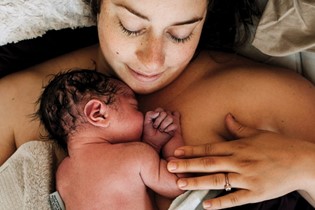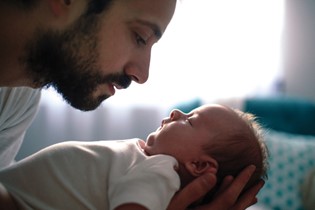Why can’t we conceive? The facts behind unexplained infertility

When fertility problems present, Dr Andrew Murray and his colleagues work hard to help family dreams become reality. But, despite the latest science, infertility can still appear somewhat of a mystery.
“My husband and I have been trying to conceive for a few years now. Testing has shown that our reproductive systems are both fine, and yet we are still not pregnant. Why could this be? Should we look into further testing?”
This is a fairly common situation, and probably one of the most frustrating for couples to deal with - unexplained infertility. Approximately 10% of the couples we see have no obvious reasons (such as ovulation issues, blocked fallopian tubes, or obvious sperm problems) why they are not conceiving. The key is to ensure that, what appears to be unexplained, really is unexplained, and that is where a fertility specialist comes in.
There are higher-level investigations available which may uncover useful information, but these tests are not always immediately obvious to GPs or general gynaecologists. For example, a sperm count may seem fine, but there could be antibodies on the sperm preventing them from fertilising the egg. A woman may in fact have endometriosis or adhesions affecting her ovarian or tubal function, but have no symptoms. These are not visible with non-invasive testing, such as ultrasound. In this setting, laparoscopy might be a sensible consideration. Some studies show up to 40% of women with fertility problems but no symptoms of pain, may in fact have endometriosis. Very occasionally ‘hostile cervical mucus’ might be discovered after doing a post-coital test. In this situation the sperm don’t survive the acidic cervical mucus.
All this to say, in the case of unexplained infertility, you really do need a fertility specialist to help direct further investigations to see if the unexplained can actually be explained.
No news can be good news
Even if the situation remains unexplained, a significant proportion of patients (up to 60% at three years) with unexplained infertility will become pregnant with time. However, the older you are when you start trying, and the longer you have been trying, the less likely the chances are of this happening. Currently publicly funded fertility treatment won’t kick in until there have been five years of unexplained infertility - in my experience, most people don’t want to wait that long.
Unexplained does not mean ‘can’t be helped’. There comes a point where we move from trying to find the reason, to just focussing on a solution - that is, getting you pregnant.
Calling for backup
The two most commonly used approaches to assist conception are either intra-uterine insemination (IUI) or in-vitro fertilisation (IVF). With IUI we usually use mild fertility drugs (low dose clomiphene and/or follicle stimulating hormone (FSH)) to recruit two to three eggs. The cycle is monitored closely so we know if too many eggs (risk of multiple pregnancy) are recruited, and secondly, so we get timing for ovulation exactly right. When the eggs are released, the prepared sperm (containing only the ‘Ferraris’ - we discard the ‘Ladas’) is placed directly into the uterus. This helps bypass any hostile cervical mucus in the cervix and gets a much larger than normal number of the fastest sperm into the uterus, thus enhancing the chances that at least one of them will find an egg.
I usually recommend no more than four attempts with IUI. Approximately 50% of couples with unexplained infertility achieve pregnancy in that time frame. However, if you are in your late 30s or older, IUI is less likely to be successful due to the reduction in egg quality that occurs with increasing age.
That is where IVF comes in. Due to a number of factors, IVF is a more effective way of achieving a pregnancy. Again, fertility drugs are used but this time in a stronger dose so that we ideally get to work with six to 12 eggs. These are retrieved from the ovaries and then put together with the sperm directly. This way we know the sperm has found the egg (something we can’t know has happened with any other treatment). The embryos that develop can then be monitored and the best one selected for replacement back into the uterus. We are now using exciting new technology, such as time-lapse imaging of the embryos, to assist with this. It would be very normal for there to only be one or two ‘rock star’ embryos to develop from 12 eggs. In fact 70% of the time with IVF, there is only one decent embryo from a whole batch of eggs. This explains why human reproduction is so inefficient. In many ways, one attempt at IVF is like compressing six to 12 months of trying naturally into one month.
A further development that is now available in our clinics is the ability to screen the embryos for abnormal chromosome number (pre-implantation genetic screening - PGS) which may further enhance the success rate of IVF for couples with unexplained infertility.
The mystery continues
Anecdotally I hear of couples who, after conceiving with assistance, then go on to conceive naturally in a subsequent pregnancy. An assumption is made that the previous treatment has somehow ‘unlocked’ a previous block to fertility. This is flawed thinking on two grounds. Firstly, with unexplained infertility we have to remember there is no obvious reason why pregnancy hasn’t happened; it’s just that after such a long time trying unsuccessfully, most want to take a pro-active approach. The second issue is that, if anything, fertility will likely be lower after a previous pregnancy, as the woman will be a little older with fewer good quality eggs.
Now that’s not to say that, once you have had fertility treatment, that this is the only way you will conceive a baby. However, it would be wise to seek help again if nature hasn’t come to the party quickly (ie six months of trying). On the flip side, once the family is complete, you should not rely on a history of unexplained infertility as contraception – there are no guarantees and you run a real risk of an unplanned ‘surprise’!
Frustrating as it is, unexplained infertility has a good prognosis. Whether it is through natural conception, IUI or IVF, over 80% of couples with this diagnosis will achieve a pregnancy. The best advice I can give is to seek the help of an expert.
|
Dr Andrew Murray is Medical Director of Fertility Associates Wellington. He is also a senior lecturer at Wellington School of Medicine and a consultant obstetrician and gynaecologist at Wellington Hospital. |

AS FEATURED IN ISSUE 38 OF OHbaby! MAGAZINE. CHECK OUT OTHER ARTICLES IN THIS ISSUE BELOW

















